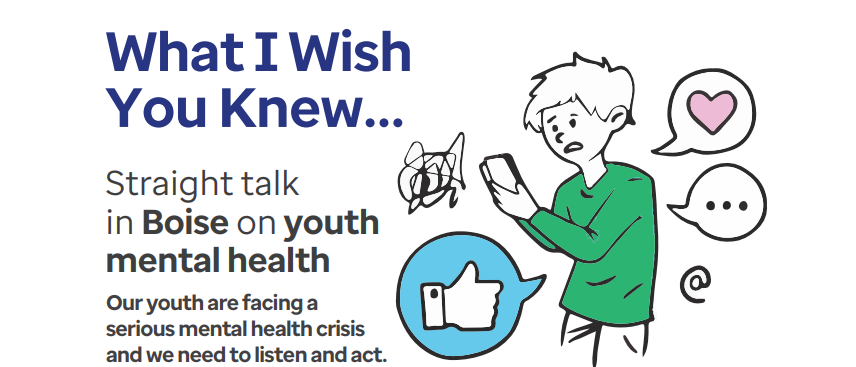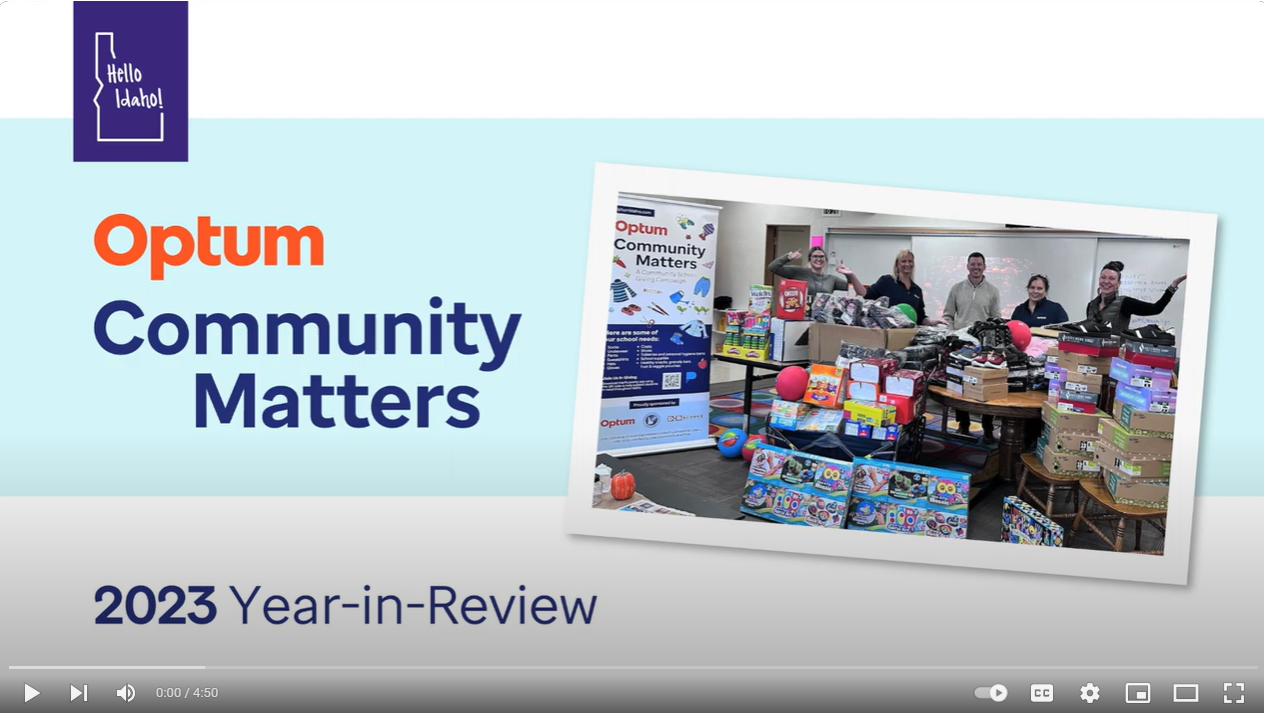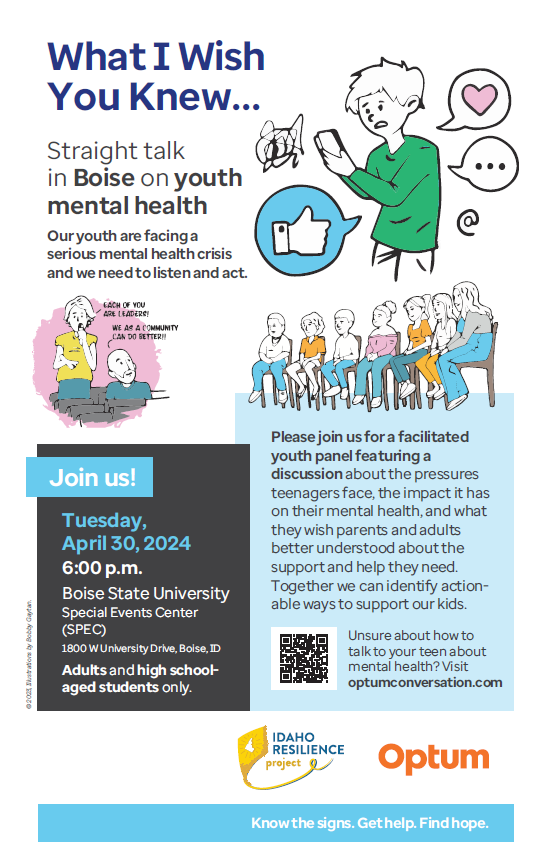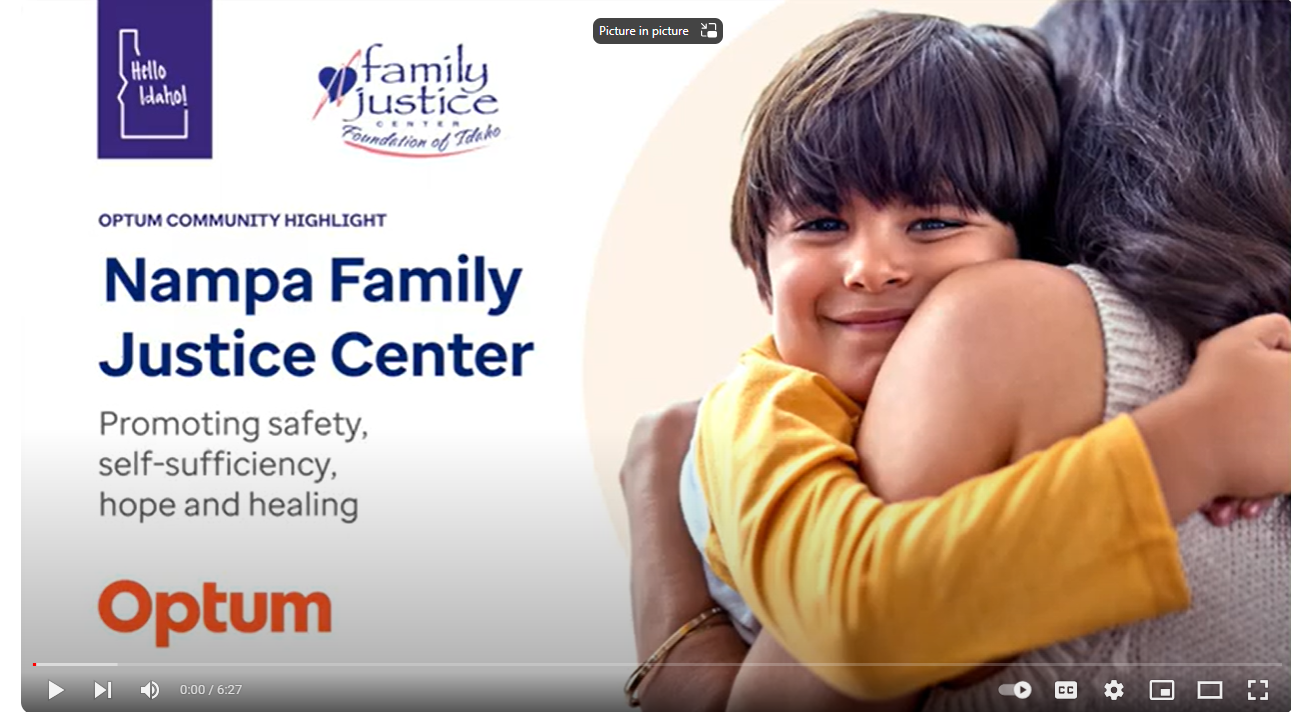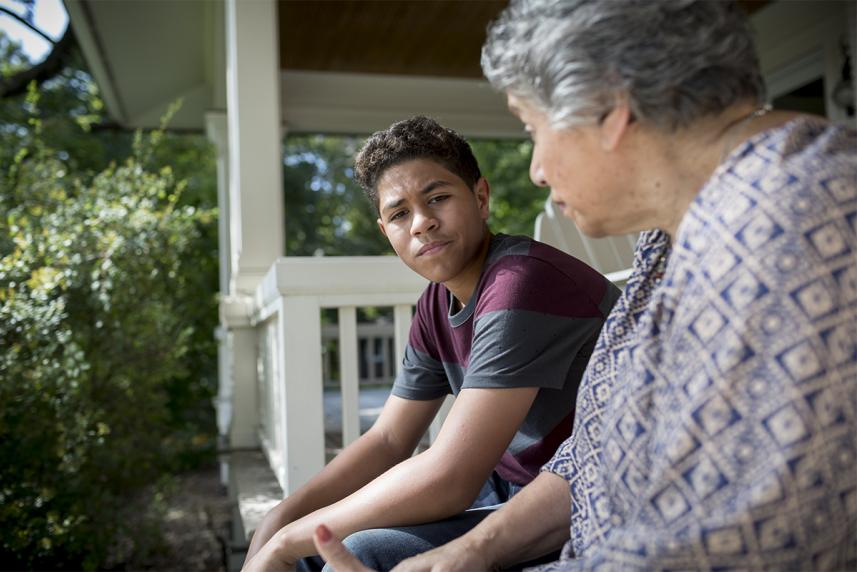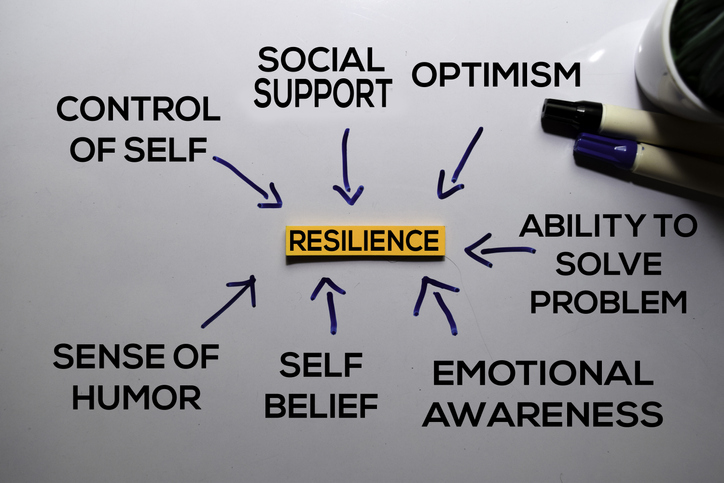In This Edition:
- YouTube video: Optum Idaho 2023 Year-in-Review: Community Matters
- Boost your self-esteem
- Upcoming event: Youth panel discussion
- Nampa Family Justice Center
- Optum Hello Idaho! resources and YouTube channel
- How to build resiliency in your child
- Idaho Behavioral Health Plan transitions to Magellan July 1
Boost your self-esteem
The way we talk to ourselves can greatly impact how we feel. By simply noticing our inner critics and treating ourselves with more kindness, we can begin to fully embrace who we are. Exactly as we are right now.
Signs Your Self-Esteem Could Use a Lift
Self-esteem is all about how we value and see ourselves. It’s the belief that we’re worthy. And that our thoughts, needs, and feelings matter. People with low self-esteem find that their moods and quality of life suffer as a result.
Sound familiar? Look for these signs that you could stand to amp up your self-esteem.
You compare yourself to others
Using other people’s lives as a benchmark is unfair. It can make you feel terrible about yourself, especially when you compare your normal ups and downs to everyone else’s highlight reels.
You struggle to express your needs
When your self-esteem dips, it can be tough to advocate for yourself. You can easily fall into the pattern of people-pleasing, thinking that other people’s needs are more important than your own.
You have trouble making decisions
Second-guessing yourself can add to the sense that you can’t do anything right and weigh down your confidence.
You engage in negative self-talk
Speaking harshly to yourself is a surefire way to lower your self-esteem.
You dismiss compliments
When your self-esteem is low, you may be tempted to discount words of praise or view them with suspicion.
Self-Esteem Boosters to Try Right Now
Be mindful about social media
It can be hard to know how to build, or rebuild, your self-esteem. Try a few of these ideas to get started.
See what works best for you. Then, practice those skills often to see your self-esteem grow. Notice what’s going on when you scroll through your feed.
Are you bored, lonely, or looking for validation? If so, step away from the device and choose a different activity, like journaling or reading.
Do certain accounts lead you to doubt your worth? Hide them for a while.
Make a hype list
Write down what you like most about yourself and your greatest accomplishments. Review your list when you’re feeling down.
Get creative
Write a poem. Dance to joyful music. Make art. Allowing yourself to be creative without judging the result can help jolt your self-esteem.
Get serious about self care
Doing things that are good for you sends the message that you’re worthy of time, attention, and care. Start small. Think of 1 simple thing you can do to take care of yourself this week. Could you take a 10-minute walk? Or get to bed by a certain time each night?
Offer up self-compassion
The next time you fall short of an expectation, talk to yourself as you would to a friend. For instance, you could say, “You’re juggling a lot, and it’s okay.”
Make plans with people that lift you up
Pay attention to how you feel around certain people. Do they leave you feeling dejected? Or do you walk away feeling seen, heard, and valued? Hang out with your biggest fans for a bump in self-esteem.
Event: Youth panel discussion on April 30
This is a free event open to the public. We hope you can attend!
The first What I Wish You Knew event was held in Nampa in Sept. 2022.
KTVB 7 coverage
*Hear from past panelist on what they wish the adults in their lives knew. Click here.
The second What I Wish You Knew event was held in Twin Falls in Dec. 2023.
Idaho News 6 coverage
Nampa Family Justice Center
The Nampa Family Justice Center (NFJC) is comprised of dedicated advocates working with community partners to provide confidential services free of charge to anyone who has experienced domestic abuse/violence, sexual assault, child abuse, elder abuse, stalking and human trafficking.
If you need assisantace, a NFJC advocate can help you create safety plans, file for protection orders, and locate helpful community resources. Many of their partner agencies are on-site, making it easier for survivors to get the assistance they need. They serve Nampa and surrounding areas and offer assistance in Spanish.
Nampa Family Justice Center referral process:
- All services are at no cost to clients
- Open Monday – Friday 8am-5pm
- Sexual Assault Nurse Examiners and Advocates 24/7
- Walk-ins are welcomed (may have to wait for an available advocate)
- To schedule an appointment, call (208) 475-5700
Click video below to learn more about the NFJC
Hello Idaho! resources and YouTube channel
Optum Idaho's Hello Idaho! campaign is about connection and reaching out to others. You can help reduce isolation, encourage inclusion and create a safe, accepting environment.
Check out Optum Hello Idaho! resources and watch the latest videos on our YouTube channel! Let’s help each other lead healthier, happier lives.
How to build resiliency in your child
5 ways to help kids cope with change and uncertainty.
f you have a child or teen in your life, consider these tips for helping them build understanding and resiliency. They’re great for parents, teachers, babysitters and other trusted adults.
#1 Start by listening.
Before you give information or advice, make sure you aren’t making assumptions about what your child already knows or how they’re feeling. Listen to your child, give them space to talk, and avoid asking too many questions, which can feel overwhelming.
Validate their feelings and answer any questions they have.1 It’s all right to say “we don’t know” if the science hasn’t been settled on a topic yet.1 If your child is having trouble talking about how they’re feeling, encourage them to try art or journaling about their emotions.2
#2 Be honest and open.
Especially for kids in middle school and high school, hearing about your own feelings can be helpful. While you don’t want to worry them, sharing some thoughts and feelings can help them feel like they’re not alone. It can also show them that they don’t always have to pretend that everything’s fine or hide their feelings. Be sure to also share the ways you are coping.2
#3 Stick to a routine.
Routines are comforting for children. Make sure they get up on time, go to school on time and follow their normal school calendar.2 If the weather allows, encourage them to get some fresh air. Make exercise, plenty of sleep and healthy meals part of the routine too.3
#4 Teach self-soothing.
Just like you may choose a solo run, a hot bath or meditation to clear your mind when you’re feeling stressed, kids can find ways to self-soothe. For some, a distraction like drawing or building a blanket fort might work. For others, cuddling with their favorite stuffed animal or spending some time outside may be calming. Encourage them to find ways to relax when uncertainty feels stressful.4
#5 Know when to get help.
Depression, anxiety and other mental health concerns are common. If your child is experiencing symptoms or is having trouble coping, seek professional help. Your employee assistance program can connect you with a licensed therapist.4
Bottom line: Resiliency is a skill that can be learned. Helping children discover how to manage stress, anxiety and feelings of uncertainty is an important life skill. But even the most resilient people still experience tough emotions. Be there for your child and try to support a positive outlook.3 Reassure your child that their feelings are valid. Then turn off the news for a while and take a break. Getting some exercise, playing a game or reading together are all great ways to spend time together.2
Sources:
- World Health Organization. #HealthyAtHome — Healthy Parenting. Accessed August 17, 2023.
- Centers for Disease Control and Prevention. Helping Children Cope With Emergencies. Last reviewed, September 1, 2020. Accessed August 17, 2023.
- American Psychological Association. Resilience Guide for Parents and Teachers. Accessed August 17, 2023.
- Magination Press Family. Kids Feeling Stressed? Help Them Learn Self-Care Skills. April 2, 2020. Accessed August 17, 2023.
Idaho Behavioral Health Plan transitions to Magellan July 1
Optum Idaho manages outpatient behavioral health services for Medicaid recipients. This is scheduled to change on July 1. The new Idaho Behavioral Health Plan (IBHP), will consolidate inpatient and outpatient behavioral health services for both Medicaid and non-Medicaid recipients under a single plan that will be managed by Magellan Healthcare, Inc. If you have any questions regarding this transition, contact IBHP@dhw.idaho.gov.
The Idaho Department of Health & Welfare press release regarding this change can be found here.
In This Edition:
- Family and Advocates Meeting open to all parents
- Are you addicted to social media?
- Talking about mental health: 4 Tips for parents of teens and young adults plus 'Conversation Starter' cards
- Holiday stress relief
- Youth behavioral health crisis centers open in Idaho
- How to spot and manage seasonal affective disorder
- The art of bouncing back: Developing resilience
- 7 Easy ways to make someone's day (including your own!)
Family and Advocates Meeting open to all parents
Did you know that there is a family engagement committee called the Family and Advocacy Subcommittee that holds monthly meetings to discuss topics related to the YES System of Care?
The objective of the meeting is to advocate that parent and youth voices are recognized by all partners as a vital contribution to the development of the YES System of Care, specifically by engaging parents, caretakers, and youth, and getting feedback and participation at all levels of project development, implementation, governance and monitoring. These meetings are open to all parents, foster parents and caretakers.
How to Attend
If you are interested in attending, the next meeting will held be on January 25, 2024 at Noon (MST). You can gain access to the virtual meeting by clicking here to receive the meeting WEBX link to attend.
Questions?
If you have questions about the Family and Advocacy Subcommittee, please contact Wendy Margolis at Wendy.Margolis@dhw.idaho.gov or calling 208-769-2748.
Learn more about the YES System of Care.
Are you addicted to social media?
Lots of people use social media every day to connect with family and friends and as a hobby. But can people get addicted to it? There’s no such thing as an official diagnosis of “social media addiction.” But it’s a term people use, because it’s more common than ever for people to overuse social media. Some experts estimate up to 10 percent of people in the United States have what’s referred to as “social media addiction.”
Why is social media so easy to overuse?
Social media platforms are engineered by teams of people to be a pleasurable and engaging experience; they are always making improvements and changes to keep the experience new and exciting. When you log on to your favorite apps, dopamine signals in your brain increase. These are associated with pleasure. But the positive feelings experienced during social media use are only temporary, and as the feel-good dopamine wears off.
What are some of the effects of social media overuse?
Engaging in social media once in a while is not harmful. But overuse can lead to:
- Low self-esteem, which is prompted by incorrect perceptions that others’ lives are “better” than yours
- Increased isolation and loneliness
- Anxiety or depression
- Reduced ability to empathize with others
How do you know if you are overusing social media?
A mental health professional can help you determine if you’re overusing social media or if it’s just something you enjoy. There are some key differences you can look for too:
- Negative effects to your job or schoolwork
- Increased use during other activities, such as hanging out with friends and family
- Increased reliance on social media as a way to cope with problems
- Restlessness and irritability whenever you’re not using social media
- Thinking about social media whenever you aren’t using it, so much so that it’s the first thing you turn to whenever you have the opportunity
If you think you have a problem, how do you decrease use of social media?
There are a number of things they can do:
- Delete your social media apps from your smartphone. While you can still access them from your PC, keeping them off your phone may help decrease the amount of time spent on social media overall.
- Turn off your personal phone during work, school, meals and other activities.
- You can also adjust the setting on each social media app so you can turn off certain notifications.
- Set aside a certain amount of time dedicated to social media per day. Turn on a timer to help keep you accountable.
- Leave your phone, tablet, and computer out of your bedroom.
- It’s also important to take regular breaks from social media altogether to help find some real-life grounding. This can be as long or short as you want. You’re in control, not your social media account.
Helpful Resources
Family Digital Wellness Guide produced by Boston Children’s Hospital’s Center on Media and Child Health is available here.
Optum Member Access & Crisis Line: 1-855-202-0973
Idaho Care Line: 2-1-1
Talking about mental health: 4 Tips for parents of teens and young adults
Mental health is an important topic
For some families, talking about mental health may be an everyday occurrence. For other families, it may be a new topic, and it may feel a little awkward at first. But the more you talk about it, the more comfortable it will feel — for you and for them.
If you’re wondering how to get started, keep these four tips in mind.
- Remember what being a teen is like. Teenagers are going through a time of change. They may be getting their first job, learning to drive, hanging out with friends more and spending less time with parents. That’s all a normal part of development. Social media may also have an impact on teens’ lives, making them feel anxious about whether others approve of them, overwhelmed by constant notifications and worried that they’re missing out. Frequent Instagram use for young women is also correlated with body dissatisfaction as well as anxiety, depression and low self-esteem.
- Watch for cues. Teens may bring up mental health topics on their own. They might mention what a friend is going through or how they’re feeling themselves. It’s important to listen, so you don’t miss these opportunities.
- Respect differences. There’s a good chance you and the teen or young adult in your life will have different opinions about political, social or other topics. While it may be tough, try to stay calm and respect their different views. This can help you build trust and make them more open to talking with you. Instead of lecturing, help your teen plan how to make healthy choices about alcohol and drugs, relationships and other topics they’ll face.
- Learn about mental health. While many people have personal experience with depression, anxiety or other mental health concerns, for some people these topics are new. If you aren’t familiar with these conditions, educate yourself before you bring them up. Also, know what signs to watch for. If someone is feeling sad or withdrawn for more than a couple of weeks, having severe mood swings, worrying a lot or getting into fights with others, they may be dealing with a mental health issue and need help.
Start the conversation
For some families, talking about mental health may be an everyday occurrence. For other families, it may be a new topic, and it may feel a little awkward at first. But the more you do it, the more comfortable it will feel: for you and for them.
If you’re wondering how to get started, and get past one-word answers, these conversation starters can help. Click either of the links below to download a digital deck of 30 conversation starters. You can print this and use it around the kitchen table, in the car or anywhere you want to strike up a conversation with a teen or young adult.
A digital deck of conversation starter cards can help.
Holiday stress relief
Feeling stress about the holidays?
While the holidays can be a wonderful time of year, there are times in our lives when we face difficulties, which can make the holidays seem incredibly challenging. Financial struggles, dealing with the loss of a loved one, managing health concerns, and many other sources of stress can feel magnified during the holidays.
What can you do if you’re feeling stressed about the holidays:
Reset expectations. This is a time of year when expectations and pressures run high to buy more expensive gifts, prepare a perfect family meal, and do more than you believe you are capable of doing. Assess your capabilities and communicate your limitations to family and friends in a respectful manner.
Don’t undervalue the importance of love. While your resources or circumstances may be less than ideal, one thing we have in abundance is our love. While we may prefer to express our love for others through beautiful gifts, we can also express it through hugs and kind words. We can express our love through a simpler gift, perhaps one we make ourselves with a handwritten note expressing how much we appreciate someone.
Express gratitude. Many needs in your life may consume your attention, which is understandable. Every day, shift your focus and look for simple blessings around you, and give thanks. Gratitude can improve your outlook during a difficult time, providing a shift in perspective that can lead to more resilient and hopeful thinking.
Reach out. You’re not alone—there are resources available to help you or a loved one if you need it:
Resources:
2-1-1 Idaho Careline: Dial 211 or 1-800-926-2588 or text 898211 to speak with a resource specialist for health and human services available in your community.
Optum Idaho’s 24/7 Member Access & Crisis Line: 1-855-202-0973 (TDD/TTY services at 711 for the hearing impaired) or visit optumidaho.com
Treasure Valley Holiday Resource List for Families
3 youth behavioral health community crisis centers are now open
Three of the Youth Behavioral Health Community Crisis Centers (YBHCCCs) are now open in Idaho Falls, Twin Falls, and Boise, with the fourth planned to open in Nampa in January 2024. YBHCCCs aim to help youth experiencing a behavioral health crisis return home and transition to outpatient supports in the community as quickly as possible, reduce strain on families, and prevent longer-term out-of-home placements.
The model used in developing the Youth Crisis Centers was based on SAMHSA’s National Guidelines for Child and Youth Behavioral Health Crisis Care. The Centers operate 24/7, accept youth ages 12-17, and will expand to ages 5-17 after the first year. Services are voluntary; each youth must have parents/guardians available to sign consent forms. No referral is needed, and all services are free of charge. Youths can stay at the YBHCCC for up to 23 hours and 59 minutes and receive stabilization, assessment, and community-based referrals. For further information, please contact the YBHCCC in your area.
Rise Up Teen and Child Crisis Center of East Idaho
1140 Science Center Dr., Idaho Falls, ID 83403
208-826-0994
ProActive Youth and Family Support Center
264 Main Ave. South, Twin Falls, ID 83301
208-969-9841 www.youthidaho.com
Pathways Youth Community Support Center
9196 E. Emerald Ste. 100, Boise, ID 83704
866-527-4747
Opening January 2024: Western Idaho Youth Support Center in Nampa, ID
How to spot and manage seasonal affective disorder
Winter can be filled with joy. We visit loved ones. We celebrate holidays. We whip up cozy recipes. We decorate our homes. But many people have a tough time. The colder months can come with heavy feelings. And for some, those can last until spring.
About 5% of U.S. adults have a form of depression called seasonal affective disorder (SAD). SAD usually shows up during winter. But not always. It can also appear during spring and summer.
SAD can be tough to spot. For one, it can look a lot like other kinds of depression. But we’ll help you learn what to look for. The good news? There are lots of ways to treat it. We’ll talk about ways to get support.
What is seasonal affective disorder?
Seasonal affective disorder is a type of major depressive disorder. It follows a seasonal pattern. “You usually start noticing it during the change in seasons,” says Giselle Alexander, LCSW, a licensed therapist and AbleTo program advisor. “It’s most common in winter.”
There are certain criteria for SAD. You need to have symptoms most of the day, for most of the week. These signs also need to last for at least 2 weeks. And they need to be present for at least 2 seasons in a row. So if you have symptoms this winter and last winter, you might have SAD.
SAD also impacts daily tasks in a big way. “You’ll see changes in your ability to function,” says Alexander. For example, it might be harder to get out of bed. It might also be tough to make a meal. Or maybe you don’t feel like seeing friends.
What are common symptoms of SAD?
Every person is different. But there are still some common signs of SAD. They are:
- Feeling down or sad
- Feeling irritable
- Loss of energy
- Changes in appetite
- Changes in weight
- Sleeping more than usual
- Sleeping less than usual
- Feeling worthless
- Loss of interest in hobbies
Symptoms can also differ from season to season.
Winter SAD may cause:
- Sleeping too much
- Eating too much
- Weight gain
- Pulling back from your social life
- Summer SAD may cause:
- Sleep issues
- Lack of appetite
- Weight loss
- Unrest
- Anxiety
Who is at risk for SAD?
Certain risk factors can increase the chances of having SAD. A few of them include:
- Being a woman
- Living in northern states
- Having depression
- Having bipolar disorder
- Having any other mental health disorder
- Having a family member with SAD
- Having a family member with another mental health disorder
What triggers SAD?
Experts still don’t know exactly what causes SAD. But research gives us a few ideas. One theory? The brain chemical serotonin. It promotes a positive mood. The brains of people with SAD have a tough time getting the balance right. Sunlight can help. Since there’s less sunlight in winter, serotonin levels may dip.
Low vitamin D levels may be another cause. Vitamin D may help make serotonin. “Sunlight is a key source of vitamin D,” says Alexander. “If you’re not going outside as much, you might see a change in mood.” This is why many people see SAD symptoms in winter.
Melatonin may also play a role. This hormone helps control your sleep-wake cycle. Too much might make you feel tired. It can also make you sluggish. Some research shows melatonin levels are too high in people with SAD.
How do health providers treat SAD?
SAD can be tricky to pinpoint. But it’s possible to get care. Here are 3 ways it can be treated:
- Light therapy. You can copy the effects of the sun with a special lamp called a light box. Some research shows using one can prevent SAD in people who have had it before. Want to give it a try? Talk to your medical provider, says Alexander. There are many types of light boxes. A provider can help you find the right kind. And they can help you use it correctly.
- Cognitive behavioral therapy. CBT can help you learn coping skills. It can also help improve mood. For SAD, you might address bummer thoughts about winter. Or, you could find ways to do more things that make you feel good.
- Medication. SSRIs have been shown to help reduce SAD symptoms. Some people take medicine only during their SAD season. Your provider can help you decide if this is a good option for you.
Can anything else help?
Feel-good habits can boost your mood. Try adding any of these to your routine:
- Get outside. Try to go outside every day — even in winter. “It’s a good idea to get some sun early in the day,” says Alexander. “It can help control your vitamin D and melatonin levels.”
- Move your body. Exercise can promote physical and mental health. Aim for 30 minutes, 3 or 4 times a week. It doesn’t have to be 30 minutes at once. You can break the time into smaller chunks.
- Connect with people. It’s hard to ask for help. But support from other people can work wonders. Try to reach out to loved ones when you’re down. A therapist can also help you manage SAD symptoms.
- Eat a balanced diet. Lots of fruits and veggies can help give you energy. Foods high in vitamin D could also help your mood. Give salmon and trout a try.
Dealing with SAD can be hard. Getting the right support matters. It can help you start to feel more like yourself. The first step is knowing the symptoms. Then you can ask for help.
The art of bouncing back: Developing resilience
Some people always seem to see the glass as half full, while others view it as half empty? The quality that helps people deal with stress and more quickly bounce back in a positive way is called resilience.1
Resilience refers to the ability to manage stress, adversity, or trauma.2 It is the ability to “bounce back” more quickly in healthier ways after relationship problems, losing a job, or other life stressors. Resilience is more than a sunny disposition. Some may be born with a temperament that lends itself to more easily manage stress in healthier ways and bounce back from life’s adversity more quickly. The good news is that recent research has shown that resilience is a quality that can be learned. It involves how to we think and how we behave. And it takes practice. One way that may help us become more resilient is by taking charge of the way we react to life’s events. Taking charge means viewing our response to life’s events as something we can control — not something that controls us. It means deciding how we will react.1
But being resilient doesn’t mean ignoring life’s ups and downs. People with resilience take the time to grieve a loss or major life change, in a way that acknowledges emotions, and helps develop coping skills to deal with life, and then move on. When confronted with a similar adverse life event later in life, they can then draw on their coping skills and emotional resources.
Resilience also doesn’t mean pretending stress and pain don’t affect us.2 Of course they do. Resilience allows us to look past our problems, manage stress, and enjoy life. Resilience can help us recover from a shock or loss in a healthy way. It can help us live with chronic pain, medical condition, or mental illness. A resilient person can meet life’s challenges with increased confidence.1
Some Characteristics of a Resilient Person
A resilient person typically is able to resist stress and weather bad times. A resilient person probably has:4
- A network of supportive people
- A sense of confidence in his or her own abilities
- Good communication skills
- Good problem-solving skills
- Techniques for managing feelings and impulses
- The ability to use coping skills gained from prior life experiences to deal with present day experiences
Ways to Develop Resilience
Make health a priority. When you eat a healthy diet, exercise regularly, and get plenty of sleep, to better meet life’s challenges.2
Lean on others. Get support from family and friends in both good and bad times. Socializing with others is important. Some people find that a faith community, volunteer group, or other organized group can be helpful for building a support network. 2
Look to the future. Keep the current setback in perspective in the long term picture. Set goals and work to meet them to help gain a sense of accomplishment. Be proactive about anticipated changes and make a plan to get through them, focusing on the things that you have the power to control.3
Learn from mistakes and successes. Think about how you’ve handled adversity in the past and learn from what worked and what didn’t. What triggers negative emotions? Can coping skills help before problems feel overwhelming?3
It’s okay to feel emotions. Resilience isn’t about bottling up emotions or denying painful feelings. It’s okay to take some time to grieve losses and not feel guilty about having emotions. Acknowledging these feelings is a healthy way to deal with life.4
Accept change. Change is part of life. When things feel out of control, focus on making realistic changes. This also includes significant people, such as friends and family—who can offer help with ways to make changes.
Learn to Trust. Develop confidence solving problems and overall making positive changes.
Overcoming significant stresses and adversity isn’t easy. Licensed counselors or employee assistance programs are available to offer tips to build a resilient attitude. Seeking help is a sign of strength, not weakness.1
Sources:
1. American Psychological Association. n.d. “The Road to Resilience.”
2. June 2019. “Traumatic Stress.”
3. Mayo Clinic. May 2017 “Resilience.: Build Skills To Endure Hardship.”
4. American Psychological Association. N.d.
7 Easy ways to make someone’s day (including your own!)
Some days get the best of us. The train is late. There’s a pop quiz in class. Your boss is disappointed. The list goes on and on. It can be hard to feel happy when it seems like there are so many factors working against us.
The good news? There’s an easy way to boost your mood that’s completely within your control. And, plot twist, it involves boosting someone else’s first.
We all have an anecdote about how being nice to someone made us feel good. Now, science is beginning to help us understand why.
Using brain imaging, researchers found that receiving money increases activity in the brain’s reward system. The same area of the brain that releases feel-good chemicals when stimulated by food or sex. But that’s not all. Donating to a charity also had the same effect. In other words, both giving and receiving kindness can produce a natural high.
I know what you’re thinking: “If you have money to donate, of course donating money feels good!” But here’s the thing, you don’t have to spend money to reap the benefits of being nice.
Take this British study for example. These researchers found that when people aged 18 to 60 carried out random acts of kindness every day for 10 days, they reported higher life satisfaction than those who didn’t. Kindness: It’s a win-win.
Share the love
In the spirit of kindness, here are 7 simple ways to spread joy and, in turn, feel that joy yourself.
Tell someone they're doin g a great job
From leaving a thank you note for your mail carrier to writing a Yelp review about a great waiter, noticing the work someone is putting in and saying thank you can make a huge difference in their day.
Let someone else go first
Slowing down often opens up opportunities to be kind. Maybe it’s letting a car merge in front of you in traffic. Or, letting a person with fewer items at the grocery store check out before you. There are countless ways being a little patient can make all the difference to someone else.
Give something other than money
What do you own that you can give away? Consider carrying items like granola bars or new socks that you can give to unhoused folks. Or, pack up used amenities that are still in good condition, like towels and sheets. Many animal shelters accept old linens to keep their animals warm.
Pay someone a compliment
It’s human nature to think that when someone is looking at you, they’re judging you. Flip this perception on its head. The next time you’re loving a stranger’s style, let them know.
Do someone else’s chores
Whether it’s a roommate, family member, or colleague, everyone gets overwhelmed. Sometimes just doing something small, like the dishes, when it’s not your turn can help someone else catch their breath.
Offer up your time
Everyone needs a break sometimes. If you know someone with kids or pets, offering to babysit or pet sit for free can be a huge help. Or you can get creative with how you offer up your donated time. Help someone clean out their closet, weed their garden, or even move house.
Get in touch
Lots of people touch our lives without ever really knowing their impact. If there’s an old teacher, coach, or friend that changed your life, send them a message of gratitude. It could be exactly what they need that day.
Kindness breeds kindness
At the end of the day, you don’t need a lot of money or a lot of time to show kindness. Sometimes, it can be as simple as making eye contact, saying hi, or just offering a smile.
If someone doesn’t wave back or express gratitude, that’s ok. Move on to the next opportunity. Kindness has a ripple effect. If you keep expressing it, it will keep coming back to you.
In This Edition:
- Kinship caregiving
- What is respite?
- Knowledge is Power: Tips for foster families
- 7 Ways to help kids manage stress
- Mental health challenges in teens
Kinship Caregiving
Kinship caregiving is a term we’re hearing more and more. However, Kinship caregiving is not anything new. In fact, families have been helping raise relative children for decades but kinship caregiving or kin care, for short, has been receiving more attention in recent years. Kinship care includes relationships developed through informal arrangements, legal custody, guardianship order, a relative foster care placement or kinship adoption.
It’s estimated that 2 million children are in some sort of kin care relationship and that 1 in 11 children lives in kinship care at some point before turning 18. [1] The organization, Grandfamilies, reports over 10,500 grandparents in Idaho are responsible for their grandchildren and for every 1 child in Foster Care, there are 13 children being raised by family outside of the foster care system. Many of these families are doing this informally and without additional support.
According to the Annie E. Casey Foundation, research shows that placement of a child with a known family member has many benefits. Some of these benefits include: 1) less difficulty adjusting, 2) less likely to experience school and social disruptions and 3) they are less likely to experience new or worsening mental health problems and are more likely to stay with siblings as well as maintain lifelong family connections. Placement with relatives also improves overall stability with fewer moves and lower re-abuse rates. So, while kinship caring can have many benefits to the child and family, raising a loved one’s child or children can also bring unexpected and difficult challenges.
Over the last few years, federal and our local governments have been creating new laws and grant funding to help ease some of the hurdles caregivers face. Optum Idaho wants to support our members and their families, by providing the following kin care resources. These local resources are packed with information about everything from navigating education, legal, tax and funding supports.
- Grandfamilies.org
- Quick Facts about Idaho-Grandfamilies Data
- IDHW Kinship and Caregiving Resources
- Community Resources - 2-1-1 Idaho CareLine (800-926-2588)
- Idaho Caregiver Alliance
These resources are easy to navigate and can provide information to help ease the transition for both the child/children and relatives. However, we understand that life can get busy and you can feel overwhelmed despite having resources. One of our member’s that’s been in a similar situation also wants you to be aware of these helpful tips:
- Don’t be afraid to ask for help from friends, other family members.
- Join a kinship support group.
- Consider taking a parenting class especially if there is one dedicated to managing challenging youth or youth that have had trauma.
- Don’t forget self-care, remember to eat right, exercise and get plenty of sleep.
- Seek counseling for yourself to help you cope with the new responsibilities and expectations of raising a child today.
- Don’t forget about Respite. This can be formal through an agency that offers respite services and or informal with family and friends.
Most of all remember “there is no right way to do kinship care, every family and situation is unique. No one will judge you for your actions taken from a place of love.”
1. https://www.aecf.org/blog/what-is-kinship-care
What is respite?
Being the primary caretaker for a child is already a heavy load to carry but throw in a serious emotional disturbance (SED) and many find themselves without time to care for their own needs. How do you get anything done? Where do you find the ability to attend your own appointments or just get a break for the sake of your own mental health? Queue respite, a short-term caregiver relief service provided by a trained individual whose purpose is to supervise youth diagnosed with a serious emotional disturbance and offer de-escalation support in stressful situations.
Respite services can be provided in a member’s home, out in the community or at a respite providers office as long as it is provided in the least restrictive environment to the youth. This is not long-term caregiving and cannot be used in place of a daily caregiver/babysitter, however, respite can include an overnight stay so long as the service does not exceed 72 hours at a time. Respite services can also be provided in the community or at a provider’s office at up to 10 hours per visit, but we’re getting ahead of ourselves. Let’s first dive into how one accesses respite services in the first place.
A SED can be defined as having both a diagnosed mental health condition and a functional impairment. To be diagnosed with a SED and qualify for the YES program that is required for families to access respite services through Medicaid, an independent assessment must be completed by a Liberty Healthcare assessor. This independent assessment is called the CANs (Child and Adolescent Needs and Strengths tool) and will determine whether the youth meets the criteria for a SED. Once the Liberty Assessment is completed and Medicaid eligibility has been approved you will then want to find an in network Targeted Care Coordinator (TCC) to write the youth’s Person-Centered Service Plan (PCSP).
Respite services can be utilized immediately after a youth has been determined to have a SED by the Liberty assessor, however, respite must be written into the PCSP in order to continue to use the service. Respite must be utilized at minimum 1 time per calendar year to maintain Yes eligibility and a maximum of 300 hours per year is offered to all eligible members under the age of 18. The independent assessment as well as the PCSP is required to be updated yearly to maintain YES eligibility and utilize respite services.
To learn more about respite services, review your benefits in the Optum Idaho Member Handbook or call the Optum Member Access & Crisis Line 1-855-202-0973, available 24/7.
Knowledge is Power: Tips for foster parents
The saying goes, “knowledge is power.” Unfortunately, as foster parents, knowledge can also be rare. Many times as a foster parent, I’ve received a call about a child in need and all the knowledge I’m provided is a gender and age—and a name if I’m lucky. Us foster parents don’t mind too much. If we weren’t flexible by nature, we wouldn’t have signed up to do what we do. However, I sincerely believe the saying, and I hope to share some knowledge today to empower my fellow foster parents—tips from an “insider” when it comes to your foster child’s Medicaid mental health benefits.
Tip 1: You can receive respite servics through Medicaid. Through the YES program, you can get up to 300 hours per year of respite care—provided by trained professionals—for your foster child. Call Liberty Healthcare (1-877-305-3469) to schedule an assessment to see if your child qualifies. Find a respite provider.
Tip 2: You do not need a referral to get into counseling. To find a provider for your foster child, use the provider search tool under the Find Care section of the Optum Idaho Member webpage. You can filter your search results by expertise like “Abuse & Trauma”, by provider gender, by age group treated and even for specific services like “youth peer support.” As always, work with the child’s case worker when starting any services.
Tip 3: Optum has a member access and crisis line. The Member Access & Crisis Line (1-855-202-0973) is available twenty-four hours a day, seven days a week, including holidays and weekends. Ask questions, find resources and discuss urgent and emergent situations with a healthcare professional. Save this number in your phone today!
Tip 4: Optum Idaho has a Transition Age Youth (TAY) guide. This guide is specifically targeted to Medicaid members (which includes foster children) that are in the 17-18 age group. The TAY guide helps provide practical guidance to members transitioning from child to adult so they can more easily navigate the Medicaid system of care during this critical time in their lives.
7 Ways to help kids manage stress
It’s easy to forget that being a kid can be stressful. As a parent of a 6-year-old, I sometimes find myself thinking things like, “She has no bills and she gets to nap whenever she wants. What’s the problem?! But the truth is that being a kid isn’t all laughter and lollipops. They have to deal with big life changes along with the rest of us. Add high-pressure exams, bullies, and social media to the mix, and it’s no wonder childhood can be stressful.
Here’s the thing, though: Not all stress is bad. “Stress can be energizing and motivate us to tackle challenges,” says Sarah Dolling, LPC, Clinical Content Producer at AbleTo. “It becomes an issue when kids are dealing with more stress than they can manage.” And, unfortunately, 70% of kids age 9 to 18 say their ability to cope with challenges is “medium” to “very low,” according to a 2022 survey. That’s where we, as parents, come in.
“Parents play an important role in shaping how kids make sense of their feelings of stress, how they cope with those feelings, and how they problem solve and plan for future stressful events,” says Hayley Quinn, PsyD, Senior Manager of Clinical Product Experience at AbleTo. “When kids learn age-appropriate ways to manage stress, they build self-efficacy and confidence. They also learn healthy boundaries, self-care skills, and how to foster healthy relationships.” Since helping our kids learn these skills can be easier said than done, we’re here to help. Below, how to identify when your kids are stressed. Plus, healthy ways to support them.
Signs your kid might be stressed
Knowing when your child is stressed isn’t always easy. Kids can express their stress differently than adults — both verbally and in how it manifests. For instance, “little kids might say they’re scared or sick,” says Quinn. “Or, some kids might express it through behavior changes.” Think: tantrums, accidents, and nightmares. That’s all OK. And normal. It just makes our job as parents a little harder.
Below are some common signs of stress to be aware of. But they’re not the only ones and some can also be signs of different issues. When in doubt, consult your child’s primary care doctor. Or reach out to a mental health provider. And no matter what, keep talking with your child.
- Irritability, anger, frequent bad moods, or other negative changes in behavior
- Sleeping too much or too little
- Inability to relax
- Difficulty regulating emotions
- New or recurring fears
- Trouble concentrating
- Neglecting responsibilities, like homework or chores
- Withdrawing from activities they used to enjoy
- Needing more help from adults
- Rigid or controlling behavior
- Avoiding or excessive clinging to parents and/or guardians
- Avoiding long-term friendships in favor of new peer groups
- Changes in appetite
- Getting sick more often
7 ways to support stressed kids
Even though we can’t remove all of our kiddos’ stressors, we can make sure they feel supported in managing them. Here are a few ways you can show up for your kid.
- Listen attentively - It can be tempting to dive in with solutions and judgment when our kids share their experiences. Instead, pause to really hear them. Be patient and ask open, curious questions like, “And then what happened?” or “And how did that feel?” “Your child may not be familiar with the word or concept of stress,” says Dolling. “This approach can help you figure out what your child is really trying to say.”
- Model resilience - When your child comes to you with a problem, you can share a personal experience from your own life. For instance, “I remember in 7th grade, there was this girl who picked on me every morning. It was so hard to get through, but here’s how I managed it.” You only want to do this, however, if your child is open to it. Be careful not to take the focus away from what they’re going through.
- Help them reframe their thoughts - Much like us, kids can get stuck in not-so-kind thought loops. When this happens, it can help to model reframing. The goal is to help shift their focus onto what they are doing well, despite the outcome. You also want to try to provide a different, healthier perspective about the situation, says Quinn. For instance, if your child says something like, “I’m bad at sports,” you might be tempted to shower them with praise. Instead, remind them of times when they worked hard and made progress. Consider: “Sports might not come easily to you. But when you work hard at something you improve fast. Remember how well you ended up doing in math class last year?” Not sure how to best reframe unhelpful thoughts? AbleTo’s 3Cs Journal takes you step-by-step through the process.
- Connect as a family - Spending time together having fun, creating something, being in nature, or making memories is a great way to offset stress. “Similar to adults, kids can sometimes fixate on a problem or see the problem as bigger than it is,” says Quinn. “Changing gears and focusing on family connection can help kids build resilience and learn healthy coping skills.” Give your child some ideas of activities you can do together. Then, let them choose what appeals to them.
- Encourage healthy sleep habits - Getting enough sleep is essential for kids’ physical and emotional wellness. The CDC recommends 9-12 hours for kids 6-12 years old and 8-10 hours for teens. To help your child get quality rest, encourage a consistent bedtime and wake time. Dimming the lights in your home after dinner can also help. As can putting away all screens at least an hour before bed. Research shows the blue light emitted by some electronics can suppress the sleep hormone melatonin. And kids may be even more sensitive to its effects than adults.
- Stick to routines - Taking some time to recharge batteries and engage in self-care activities can be helpful. But it’s best to maintain routines — such as school, regular meals, and family rules — as much as possible. “Children need structure and routine to thrive,” says Quinn. “Predictability and daily rhythms can help offset the impact of stress. They also help kids develop self-esteem and allow for healthy distraction.”
- Prioritize your own self care - Trust me, I know there’s nothing more annoying than having someone preach “self care” when you’re an exhausted and overwhelmed parent. But, taking care of ourselves allows us to better support others. Here are 7 healthy and realistic ways to practice self care.
The kids will be all right
Watching our kids struggle is the pits. So remember to be patient with yourself as you figure out how to best help them. At the end of the day, just being there to offer a listening ear and a supportive hug will go a long way. Sure, our kids will always face stressful times. But with our help, they’ll become better equipped to navigate all that life brings their way.
By Katie Nave
Mental health challenges in teens
Learning the signs and symptoms, and how to help
It’s a time of intense stress and pressure for teens today, coming from a variety of directions. For parents, teachers, mentors and others caring for young people, it can be very important to understand how to identify to signs of distress and help them get the assistance they need.
What anxiety, depression or suicidal thoughts might look like
Common signs that a teen or young person might be in distress:
- Pulling away from friend groups without integrating into an alternative group
- Quitting extracurricular activities without replacing them with something else
- Change in hygiene or drastic changes in appearance
- Looking or acting more tired than usual
- Victim of assault or bullying
- Sudden lashing out at teachers or fellow students
- Isolating themselves during lunch or group activities
- An uptick in unexplained absences
- Sudden change in grades or stop completing assignments
- An elevated mood after a period of depression(can be associated with suicidal thoughts)
- Talking, reading, or writing about death or suicide (can be associated with suicidal thoughts)
How can you help a teen struggling with mental health challenges?
Listen. You don’t need to feel like you have to solve their problems or give advice, but being available to listen can be one of the most important things you can do to help someone struggling.
Don’t judge. Show that you’re concerned in a way that is not confronta-tional or judgmental. Let them know that you care about them and are checking in because of concern.
Keep questions simple. Ask how they are doing, what they are feeling and how you can help.
Offer hope. Reassure them. Let them know they are not alone and you are there to support them.
Provide a safe, supportive environment. Feeling connected to supportive adults in a stable environment is critical to a young person’s wellbeing and often helps reduce substance abuse, mental health issues and other risky behaviors.
Suggest resources. Have local support resources ready to share or offer to find those resources together.
Stay connected. After your initial conversation, stay engaged and check in regularly. Let them know that you are still there.
Support Resources in Idaho
If you need additional help, seek advice from your healthcare provider.
If you need immediate crisis help, you can call or text the National and Idaho Suicide & Crisis Helpline at 988, or chat at 988lifeline.org. Someone is available to help you 24/7.
2023 Newsletters Winter || Spring || Fall
2022 Newsletters Winter || Spring || Fall

